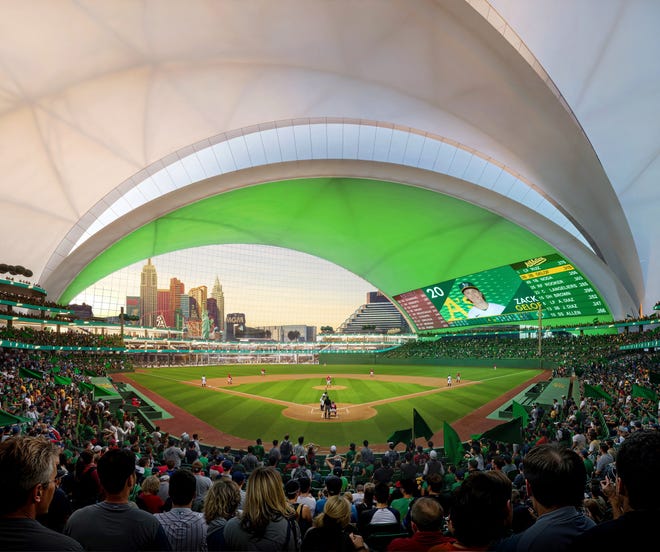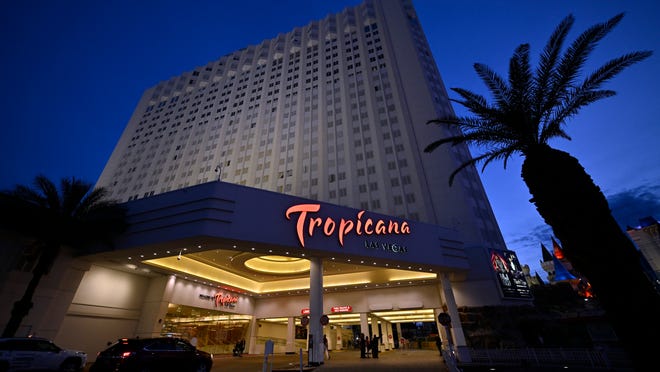2024-10-09 22:30:03
LAS VEGAS – The Tropicana had a lengthy history, by Las Vegas standards.
The hotel-casino debuted in 1957. Nicknamed the “Tiffany of the Strip” for its grandeur, the resort made a name for itself through its entertainment offerings, with stages showcasing the long-lasting showgirl revue Folies Bergere and big-name jazz performers like Louis Armstrong.
The property stood for nearly 70 years on the Strip.
Bringing it down took less than 30 seconds.
Around 2:30 a.m. Pacific on Wednesday, more than 2,000 pounds of explosives took down the Tropicana’s Paradise Tower and Club Tower in roughly 22 seconds. It was Las Vegas’ first implosion in nearly a decade, opening up space on the Strip for a new Major League Baseball stadium for the Athletics, formerly of Oakland, California.
“Let’s not think of it as an ending, but as the beginning of something even greater,” Arik Knowles, general manager and vice president of hospitality at the Tropicana, told spectators Wednesday morning.
‘It’s a work of art’
The send-off included a 555-drone and fireworks display timed to tunes from Vegas legends like Frank Sinatra and Elvis Presley, with drones creating images of the iconic Welcome to Fabulous Las Vegas sign and the Athletics logo.
There were no public viewing areas for the implosion due to safety restrictions, and an invite-only event had an estimated 500 spectators in attendance. That didn’t stop people from flocking to Las Vegas in hopes of catching a glimpse of the show.
Room rates for surrounding hotels jumped the night of the implosion. Mandalay Bay, which hosted an implosion watch party at a rooftop venue, had room rates starting at $699 Tuesday night, compared with less than $80 for a stay on Thursday. Other hotels close to the implosion site like the Excalibur, Luxor and Oyo were fully booked, according to their websites.
Steve Crupi, a former TV news reporter known as the “implosion guy” after covering every major Las Vegas implosion, told USA TODAY he’s used to seeing large crowds gather to watch casinos fall.
“There’s something magical about implosions,” he said. “A structure that big being brought down in as little as 5 seconds? It just seems impossible. And yet they do with such precision and such artistry, that it really is just more than an act of demolition. It’s a work of art.”
Tropicana performers share memories:The Tropicana was once ‘the Tiffany of the Strip.’ For former showgirls, it was home.
This isn’t Las Vegas’ first foray into using explosions to boost tourism. In the 1950s, the city’s chamber of commerce leaned into atomic tourism, going so far as to issue a calendar for tourists with a bomb detonation schedule and viewing sites, according to PBS.
“It’s just part of that human fascination for things going boom,” said David Schwartz, an affiliate history professor at the University of Nevada, Las Vegas.
By the time the Las Vegas Strip had its first resort implosion, the city was well-versed in turning explosions into spectacles.
For the Dune’s 1993 implosion, Treasure Island’s pirate ship appeared to fire its cannons toward the 38-year-old property. Cannons blasted, hundreds of pounds of explosives were set off, and the resort crumbled.

More hotel-casino implosions followed, with the likes of the Stardust, Aladdin and the Desert Inn falling in clouds of dust. The Riviera was the last Strip resort to implode before the Tropicana, with a 2016 demolition.
“There’s been a dry spell,” said Mark Loizeaux, president of Controlled Demolition, Inc. The Phoenix, Maryland-based company has overseen every major Las Vegas property implosion going back to the Dunes.
Like the other resorts that fell before it, the Tropicana’s fall was meticulously planned.
The towers were gutted in advance, Loizeaux said, and walls were torn down to limit “dust creators.” The property’s implosion was planned for early on a weekday for less wind and traffic.
The goal, Loizeaux said, is to “get these structures down quickly, safely, and let things return to normal” for the community and its casinos.
Let’s play ball
Las Vegas is known for many things. Being stagnant is not one of them.
The city has a habit of reinventing itself, going from its mobbed-up Rat Pack era to one focused on building out megaresorts.
Now, the city has a shiny new focus: sports.
The Tropicana’s fall is meant to pave room for the city’s fourth major league sports team, with Bally’s Corporation (a gambling company) and the Athletics planning to open a new resort and ballpark where the Tropicana once stood.

Nine acres will go toward a $1.5 billion, 33,000-seat indoor stadium. The rest will be set aside for a new casino resort.
Details for the attached resort are still being worked out, according to Bally’s chairman Soohyung Kim. There’s no opening date for the resort, but the ballpark is planned to open for the 2028 MLB season.
Kim said the Tropicana was an “amazing” casino with a rich history tied to classic Las Vegas icons like the Rat Pack and showgirls. But Vegas, he said, is not a sentimental town.
“It understands that in order to remain the tourism capital of America … it needs to keep building and growing,” he said. “We understand that what comes out of that, including a baseball stadium, needs to contribute to the health of the entire city. And I think we’re going to do a great job, and I think it’s going to be an amazing asset for the city.”
(This story was updated to change or add a photo or video.)





